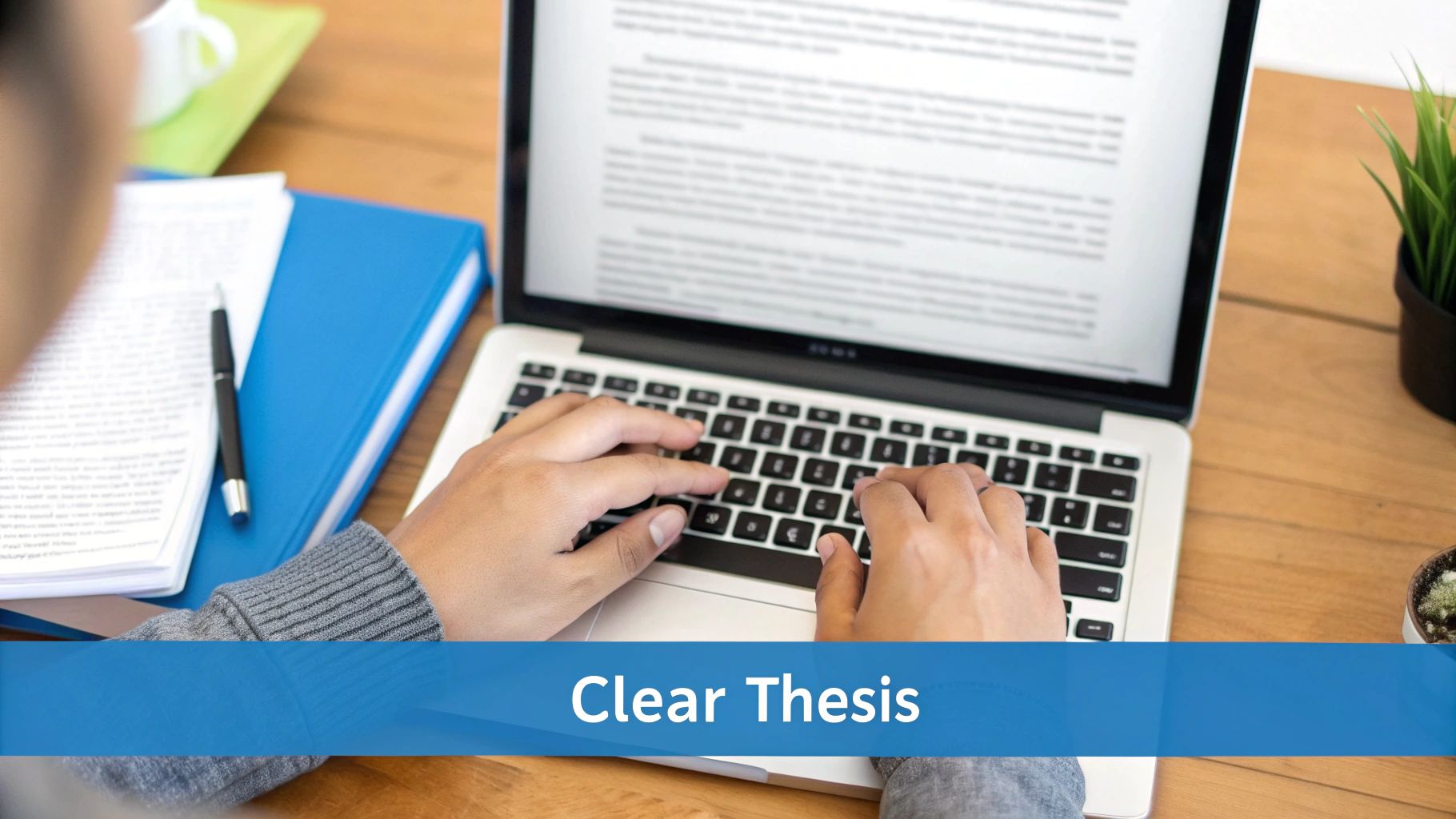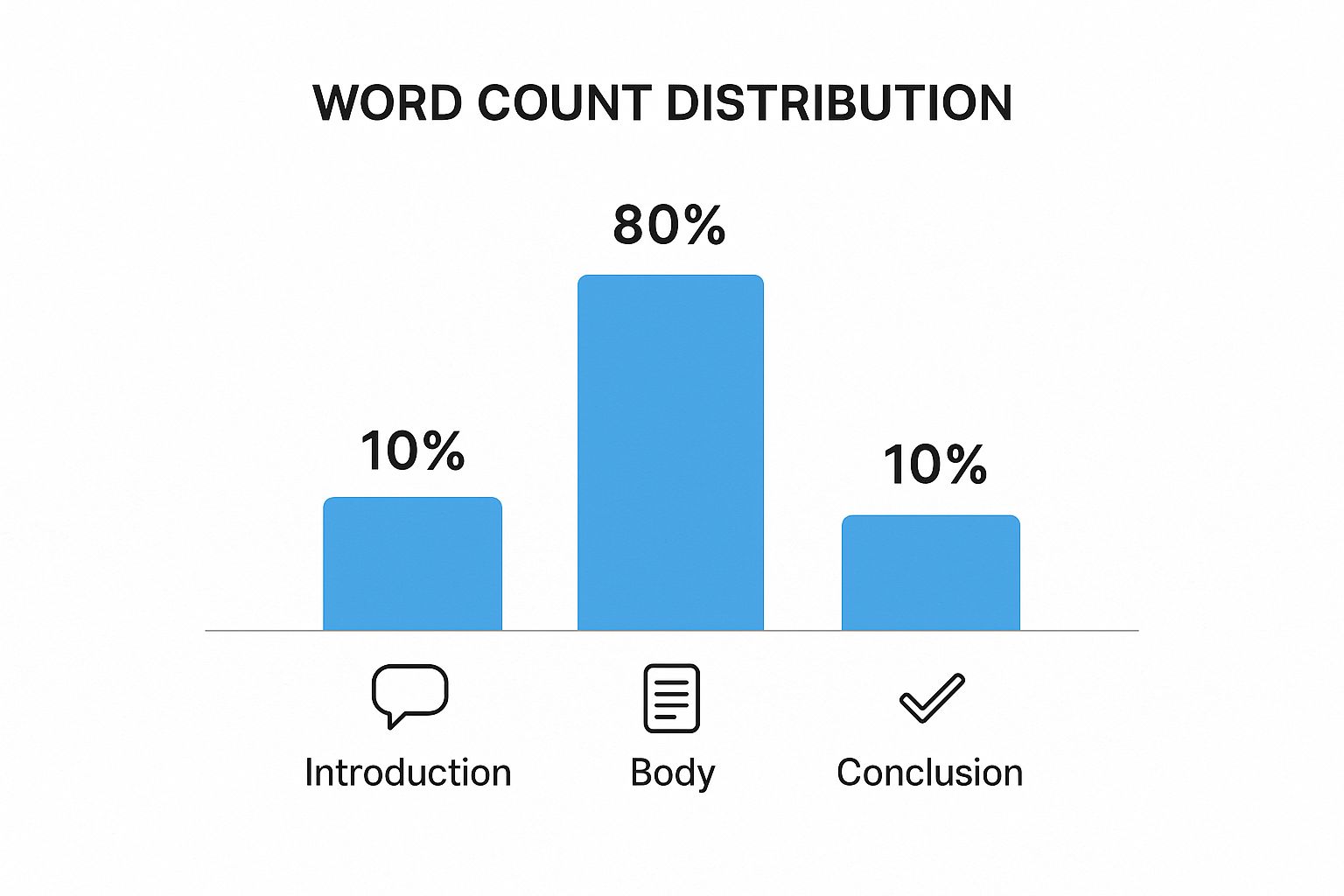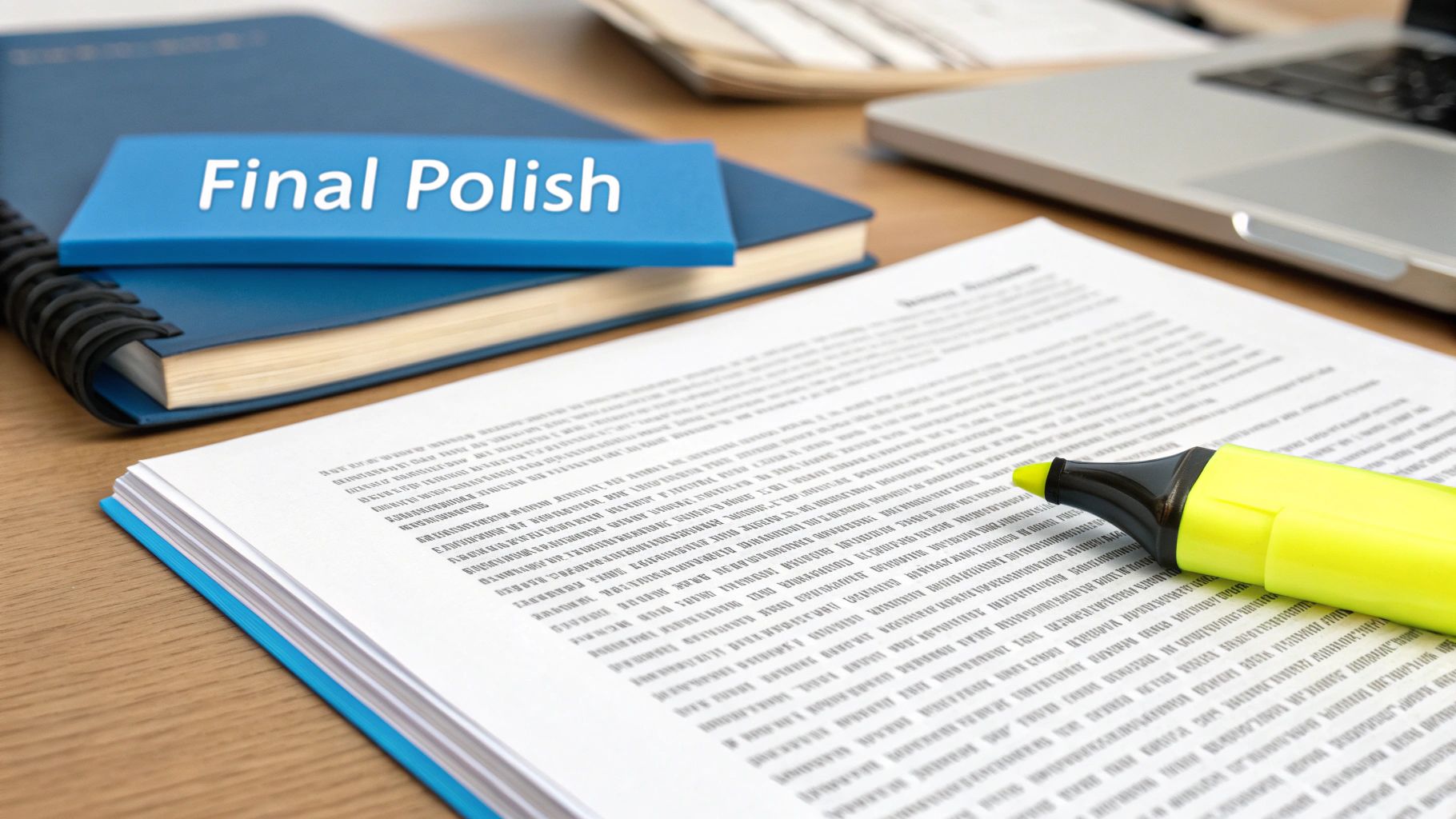The Building Blocks of Exceptional Essays

Exceptional essays aren't conjured out of thin air. They are carefully constructed using key building blocks. When combined effectively, these elements elevate your writing from satisfactory to truly outstanding. Let's explore these essential foundations, drawing on insights from both seasoned professors and successful students.
Defining Your Core Argument: The Thesis Statement
Every strong essay relies on a clear and compelling thesis statement. This isn't simply a topic; it's the central argument you're aiming to prove. A weak thesis offers a general observation. A strong thesis, however, takes a definite stance.
For example, instead of stating "Shakespeare's plays are interesting," a more effective thesis would be "Shakespeare uses dramatic irony in Hamlet to expose the corrupting influence of power." This revised version offers a focused, arguable position.
Structuring Your Support: Logical Argumentation
A well-crafted essay presents supporting arguments logically. Think of each paragraph as a building block contributing to the overall structure. Each paragraph should begin with a topic sentence directly related to your thesis. This topic sentence introduces the specific point you'll support with evidence.
Use transitional phrases to guide the reader through your reasoning. This creates a clear, cohesive flow, ensuring each point builds upon the previous one.
Evidence and Analysis: The Foundation of Persuasion
Convincing arguments rest on solid evidence. This might include statistics, expert opinions, historical context, or textual analysis. Presenting evidence alone is insufficient; you must also analyze it.
Explain how your evidence supports your claims and why it's significant. For example, if quoting a literary critic, don't just insert the quote. Analyze its meaning and connect it back to your thesis. You may also find resources on how to master essay generation helpful.
Understanding Your Audience: Writing With Purpose
Consider your audience's expectations and background knowledge. What are their existing understandings? What do you need to persuade them of? Exploring different perspectives can be valuable; you might find inspiration from investing & personal finance blogs & podcasts.
Tailoring your writing to your audience ensures your message resonates effectively. This is crucial for achieving your essay's objective, whether it's to inform, persuade, or analyze. This focus on effective essay writing is reflected in the growth of the global essay writing platform market. Valued at approximately USD 1.97 billion in 2024, it's projected to reach USD 4.35 billion by 2032, with a CAGR of 9.2%. More detailed statistics are available here.
These core components—a clear thesis, logical argumentation, supporting evidence, and audience awareness—form the foundation of exceptional essays. By mastering these elements, you'll create essays that not only achieve high marks but also demonstrate a deep understanding of your subject.
Crafting Intros That Hook Readers and Professors Alike
The introduction to your essay is more than just a starting point; it's your opportunity to grab your reader's attention. Successful students recognize the power of a well-crafted introduction. They understand that it's not just an obligatory paragraph, but a strategic tool for engaging their audience and setting the tone for their entire essay. This section explores how to elevate your introductions from simple preambles to compelling invitations.
The Psychology of a Strong Introduction
Different introduction strategies resonate differently depending on the essay's purpose and audience. Considering the psychology behind these various approaches can help you choose the most effective one:
-
The Intriguing Question: Starting with a thought-provoking question immediately piques the reader's curiosity and encourages them to seek answers within your essay.
-
The Bold Statement: A striking declaration can capture attention and establish your confidence in your argument. However, it's crucial to back up bold statements with solid evidence in the body of your essay.
-
The Anecdotal Opening: A short, relevant anecdote can create a personal connection with the reader, making your topic more relatable and human. This approach can be particularly effective for essays that explore personal experiences or social issues.
-
The Historical Context: Providing historical background can frame your argument within a broader narrative and give your reader essential context. This approach is especially useful for essays on historical topics or those that require a deeper understanding of the subject's origins.
Choosing the right approach is essential for creating an introduction that aligns with your essay's overall tone and objective.
From Vague Promises to Focused Thesis Statements
Your thesis statement is the foundation of your essay. It should be clear, concise, and arguable. A weak thesis statement offers vague generalizations, while a strong one presents a specific, focused argument. Let's look at some examples:
To illustrate this further, consider the following table:
"Thesis Statement Comparison: Strong vs. Weak Examples"
"This table compares weak thesis statements with their improved versions, demonstrating how to transform vague claims into focused, arguable positions"
| Weak Thesis Statement | Improved Thesis Statement | Why It's Better |
|---|---|---|
| Social media is bad. | The addictive nature of social media contributes to decreased attention spans in young adults. | Provides a specific argument and identifies a clear consequence. |
| Shakespeare's plays are complex. | Shakespeare’s use of imagery in Macbeth enhances the play’s exploration of ambition and guilt. | Focuses on a specific literary device (imagery) and connects it to thematic elements (ambition and guilt) of the play. |
| Pollution is a problem for the environment. | Industrial pollution disproportionately affects marginalized communities, exacerbating existing health disparities. | Narrows down the topic to a specific type of pollution (industrial) and its impact on a particular group (marginalized communities), creating a more compelling argument. |
The table clearly demonstrates how a strong thesis statement provides a roadmap for the essay, ensuring that every subsequent paragraph contributes meaningfully to your central argument. A well-defined thesis statement helps both you and your reader stay focused on the main point.
Finding the Right Balance: Context vs. Analysis
A common mistake in essay introductions is providing too much background information without clearly connecting it to the central argument. The key is to strike a balance between providing necessary context and engaging in insightful analysis. Think of your introduction as a funnel: start broad and gradually narrow your focus towards your thesis statement. This approach keeps the reader engaged while establishing the direction of your essay. By mastering this balance, you create introductions that set the stage for compelling arguments and insightful analysis. These skills will enhance not only your essays but also your writing abilities for future academic and professional endeavors.
Building Arguments That Actually Convince Your Reader

Exceptional essays move beyond simply stating opinions. They construct compelling arguments through strategic organization and well-placed evidence. This section explores how accomplished academic writers craft paragraphs that actively advance their arguments, transforming essays into persuasive writing.
Structuring Paragraphs for Maximum Impact
Think of each paragraph as a mini-argument supporting your essay’s overall claim. Each one needs a clear topic sentence relating directly to your thesis. This sentence acts as a guidepost, signaling the specific point being addressed. For example, if your thesis argues for the importance of renewable energy for a sustainable future, a topic sentence might focus on the economic benefits of solar power.
Transitional phrases are also key. Words like "Furthermore," "However," and "In contrast" guide the reader through your reasoning, creating a smooth flow. Concluding each paragraph with a sentence linking to the next topic enhances this cohesive structure, building momentum and guiding the reader through your argument step by step.
Integrating Evidence Effectively
Compelling arguments rely on solid evidence. This might include statistical data, expert opinions, historical context, or textual analysis. However, simply presenting evidence isn't enough. It requires analysis and explanation.
Explain how the evidence supports your claim and why it’s relevant. Consider crafting a compelling introduction using tools like a LinkedIn Hooks Generator. This ensures your introductory paragraph connects with the audience while introducing the evidence. Analyzing your evidence demonstrates critical thinking and distinguishes insightful writing from summarization.
Anticipating Counterarguments: Turning Weakness into Strength
Strong arguments not only present supporting evidence but also address potential counterarguments. This shows intellectual honesty and strengthens your overall position. By anticipating opposing viewpoints, you preemptively address them, turning potential weaknesses into opportunities to demonstrate your understanding. For example, when arguing for stricter environmental regulations, acknowledge the potential economic costs while emphasizing the long-term benefits.
Refuting counterarguments effectively reinforces the validity of your claims. It shows you've considered multiple perspectives, strengthening your credibility. This nuanced approach creates a more robust and persuasive essay. The global essay writing service market, valued at USD 1.97 Billion in 2023, is projected to double by 2032, highlighting the demand for writing support. Find more detailed statistics here.
Building Momentum Through Transitions
Smooth transitions between paragraphs are crucial for a convincing argument. Avoid abrupt shifts. Instead, use transitional sentences and phrases to create a natural progression of ideas. This creates flow, allowing the reader to easily follow your reasoning.
For example, phrases like "Building upon the previous point…" or "In contrast to the earlier example…" create clear connections. This careful linking is essential for effective essay writing, building a cohesive and compelling argument. By weaving together each paragraph, you create a compelling narrative leading the reader towards your conclusion.
Leveraging Technology Without Surrendering Your Voice

The infographic above illustrates the recommended word-count distribution for a well-structured essay. It allocates 10% to both the introduction and conclusion, leaving 80% for the body paragraphs. This visual emphasizes the importance of a concise introduction to set the stage, a substantial body for core arguments, and a succinct conclusion to reinforce key takeaways. This balance ensures each section contributes effectively.
Numerous digital resources are available for essay writers. The key to using them successfully is integrating these tools without over-reliance. This section explores how proficient students use technology to refine their writing while maintaining their unique voice.
AI-Powered Assistants: Enhancing, Not Replacing, Your Skills
AI writing tools can be valuable assets for essay improvement. These assistants offer feedback on grammar, style, and plagiarism, helping writers refine their prose. For instance, grammar checkers catch easily overlooked errors, while style guides offer suggestions for sentence structure and word choice. This support frees up mental energy for focusing on the core argument and analysis.
However, using these tools as aids, not replacements for critical thinking, is crucial. Solely relying on AI can lead to generic-sounding prose and a lack of original thought. Remember, these tools assist, they don't write the essay. Your unique perspective and analytical skills truly make an essay stand out.
Advanced Grammar Tools: Polishing Your Prose
Advanced grammar tools are particularly helpful during revisions. They help identify and correct grammatical errors, ensuring clear and error-free writing. Some tools even offer insights into tone and clarity, contributing to a more polished and professional piece.
These tools do have limitations. They may not always catch subtle nuances in language or understand the context of your arguments. Combining technological assistance with your own understanding of grammar and style is essential. Think of these tools as a second pair of eyes, but always trust your judgment as the final editor.
Finding Your Technology Balance
Developing a personalized strategy is the most effective way to leverage technology. Identify your writing challenges. Do you struggle with grammar, complex sentences, or organizing thoughts? Once you pinpoint your weaknesses, choose tools that address those areas.
Technological advancements have transformed how we hone writing abilities. AI-driven assistants offer real-time feedback, empowering users to polish essays more effectively. This AI integration is changing how we improve our skills. By 2025, AI is projected to reshape millions of jobs, creating 97 million new roles (many related to using AI tools) despite a projected loss of 85 million other jobs. Discover more insights about AI’s impact here.
To help you choose the right tools, let's compare a few popular options:
The following table summarizes the key features, limitations, and costs of several writing enhancement tools.
Popular Writing Enhancement Tools Comparison
A detailed comparison of leading writing tools to help you select the most appropriate resources for your specific essay writing needs
| Tool Name | Best For | Key Features | Limitations | Cost |
|---|---|---|---|---|
| Grammarly | Grammar and style checking | Real-time feedback, plagiarism detection, tone detector | Can be expensive, some features require premium version | Free and premium plans |
| ProWritingAid | In-depth writing analysis | Style reports, grammar checking, readability analysis | Can be overwhelming for beginners, limited collaboration features | Free and premium plans |
| Hemingway Editor | Simplifying writing | Highlights complex sentences, adverbs, passive voice | Doesn't offer grammar checking, limited features | Free and premium plans |
| Google Docs | Collaborative writing | Real-time collaboration, basic grammar and spell check, free to use | Limited advanced features | Free |
This table provides a quick overview of some popular tools. Choosing the right combination will depend on your individual needs and budget.
The Importance of Maintaining Your Voice
While technology refines writing, maintaining your unique voice is paramount. It’s what makes your essays authentic and engaging. Your personal experiences, perspectives, and insights are valuable; don't let them get lost.
Use technology strategically to improve your writing mechanics, but let your personality and critical thinking shine. This is what sets your work apart and captures readers’ attention. Remember, the goal is to write better essays, not to have essays written for you. Finding the right balance between technology and personal expression significantly enhances your writing while preserving your individual voice.
Transforming Rough Drafts Into Polished Submissions
The secret to a truly exceptional essay often lies not in the initial burst of writing, but in the meticulous rewriting that follows. Think of your first draft as the clay model of a sculpture—the basic shape is present, but it requires careful refinement to reveal its true brilliance. This section explores systematic revision strategies, gathered from discussions with high-achieving students, to help you elevate your work from a rough draft to a polished submission.
Moving Beyond One-Size-Fits-All Revisions
Many students approach revision as a single, monolithic task. However, a more effective strategy involves dividing the revision process into distinct phases, each with a specific focus. This targeted approach provides a clear roadmap and allows you to concentrate your energy where it's needed most.
-
Phase 1: Structure and Argument: Begin by evaluating the overall structure of your essay. Is your thesis statement clear, concise, and compelling? Do your arguments progress logically? This phase is all about the big picture, ensuring a solid foundation before delving into the finer details.
-
Phase 2: Evidence and Analysis: Next, examine the supporting evidence you've presented. Is your analysis insightful and persuasive? Does the evidence effectively support your claims? This phase focuses on ensuring your argument is not just stated, but thoroughly substantiated.
-
Phase 3: Clarity and Style: Finally, refine your writing style. Are your sentences clear, concise, and engaging? Have you used strong verbs and varied sentence structure? This phase polishes your prose, making it accessible and enjoyable to read. You might find Grammarly helpful in this phase.
This structured approach, moving from macro-level concerns to micro-level details, breaks down the daunting task of revision into manageable steps.
The Power of Feedback: Seeking and Incorporating Input
Seeking feedback is crucial for identifying weaknesses you might have overlooked. Professors, writing centers, and peers can provide valuable perspectives. However, receiving feedback is only the first step. Learning to incorporate it effectively is equally important.
-
Be Open to Criticism: Don't take feedback personally. View it as a valuable opportunity for growth and improvement. Even seemingly harsh criticism can offer valuable insights.
-
Ask Clarifying Questions: If you're unsure about a particular piece of feedback, don't hesitate to ask for clarification. Understanding the reasoning behind the suggestion is essential for making meaningful revisions.
-
Prioritize Revisions: Not all feedback carries the same weight. Focus on implementing the most impactful suggestions, especially those concerning your argument's clarity and structure. Consider using How to master grammar for guidance.
By actively seeking and incorporating feedback, you gain valuable insights that strengthen your writing and ensure a more polished final product.
Common Revision Blind Spots: Avoiding Overlooked Errors
Even seasoned writers can fall prey to common revision blind spots. Being aware of these potential pitfalls can help you catch and correct them before submitting your final draft.
-
Overly Complex Sentences: While complex sentences can demonstrate sophisticated writing, excessively long sentences can obscure your meaning. Strive for clarity and conciseness.
-
Repetitive Language: Using the same words or phrases repeatedly makes your writing monotonous. Vary your language to maintain reader engagement.
-
Lack of Transitions: Smooth transitions between paragraphs are essential for a cohesive and well-structured essay. Ensure your ideas flow logically and are clearly connected.
-
Ignoring the Conclusion: The conclusion is your final opportunity to leave a lasting impression on the reader. Don't rush it. Reiterate your main points and offer concluding thoughts.
By addressing these common revision pitfalls, you can ensure that your essays are polished, compelling, and ready for submission.
Breaking Through Your Personal Writing Roadblocks

Every writer, from beginner to seasoned pro, faces their own set of challenges. This section focuses on identifying and overcoming the specific roadblocks that might be holding you back from writing better essays. We'll explore practical solutions for common obstacles, using strategies proven successful by other students who have tackled these same difficulties.
Conquering Procrastination: From Inertia to Action
Procrastination is a common hurdle for many. Understanding its root causes can help you develop effective countermeasures. Often, procrastination stems from feeling overwhelmed by the sheer size of the task. Breaking the essay writing process down into smaller, more digestible steps can make the whole project seem less daunting.
For example, instead of seeing the essay as one monolithic assignment, divide it into distinct phases: brainstorming, outlining, drafting, and revising. This allows you to concentrate on one stage at a time, minimizing feelings of overwhelm and fostering a sense of accomplishment. Setting realistic deadlines for each phase further strengthens this approach.
Overcoming Writer’s Block: Reigniting Your Creative Spark
Writer's block can feel like hitting a wall. This frustrating experience often arises from perfectionism or a fear of failure. Remember, your first draft doesn't have to be perfect. In fact, giving yourself permission to write freely, without self-criticism, can help break through the block.
Try freewriting for a specific amount of time, say 10 minutes, concentrating on getting your thoughts down without worrying about grammar or style. This can jumpstart your writing and lead to unexpected insights. Sometimes, simply changing your writing environment, like moving from your desk to a café, can also trigger new ideas.
Integrating Research Seamlessly: Weaving Evidence Into Your Narrative
Many students find it difficult to effectively incorporate research material. Instead of just inserting quotes, strive to integrate evidence smoothly into your writing. Introduce quotes with context, clarifying their connection to your argument.
Furthermore, analyze the evidence, demonstrating how it supports your claims. This goes beyond summarizing the research and shows your understanding of its significance. Your analysis is what sets your essay apart from a simple compilation of sources.
Enhancing Clarity for Non-Native English Writers: Building on Your Strengths
Non-native English writers may face particular challenges with vocabulary, grammar, and sentence structure. Concentrating on clear and concise sentences can greatly improve the readability of your essays.
Using online grammar checkers, like those offered by SmartStudi, can help identify and correct errors, but they shouldn't replace careful proofreading. Getting feedback from native English speakers can also offer valuable perspectives on areas needing refinement. Clear communication is key, regardless of your language background.
Editing for Precision: Transforming Verbosity Into Concise Arguments
Many writers mistakenly equate longer sentences and complex vocabulary with sophisticated writing. However, concise writing is often more effective. Editing for precision involves removing unnecessary words and phrases, ensuring that every sentence contributes to your argument.
For instance, replace phrases like "due to the fact that" with the simpler "because." This streamlines your writing and strengthens your arguments. Using strong verbs and precise nouns enhances clarity and impact. By mastering these techniques, you can turn wordy paragraphs into powerful, concise arguments.
Mastering Multiple Essay Formats For Academic Success
Your academic journey will require you to write various types of essays, each with specific requirements. Learning to recognize the subtle clues in assignments that indicate the appropriate approach is crucial for academic success. This section explores how successful students adapt their writing process to excel in different essay formats.
Identifying the Right Essay Format
Understanding the different types of essays is the first step toward effective writing. Just as a carpenter uses different tools for various tasks, writers must adapt their approach based on the essay's objective. This allows for proper structuring of arguments and evidence. Common academic essay formats include:
-
Argumentative: These essays present a clear stance on a topic and offer supporting evidence to persuade the reader.
-
Analytical: Analytical essays dissect a topic, examining its components for a deeper understanding.
-
Comparative: These essays compare and contrast two or more subjects, highlighting similarities and differences.
-
Narrative: Narrative essays tell a story, often using personal experiences to illustrate a point.
-
Research: Research essays explore a topic using external sources to support the writer's claims.
Recognizing cues in assignment prompts, such as words like "compare," "analyze," or "argue," is essential for selecting the correct format.
Tailoring Your Approach for Each Format
Once you've identified the essay format, adapt your writing process. This includes tailoring:
-
Structure: An argumentative essay needs a clear thesis statement supported by logic and evidence, while a narrative essay might follow a chronological structure.
-
Evidence: A research essay relies on external sources and meticulous citations, while an analytical essay might focus on close reading and textual analysis.
-
Style: A narrative essay may use descriptive language and figurative devices to create imagery, while an argumentative essay maintains a formal tone, focusing on logic and factual accuracy.
Maintaining Your Voice Across Different Formats
Adapting to different essay formats is essential, but so is maintaining your unique voice and perspective. This means balancing the specific requirements of each format with your personal writing style. It's about finding the right tone, choosing resonant words, and crafting sentences that reflect your individual rhythm.
Think of a musician playing different genres. They adapt their technique and style, but their unique musical voice remains. Similarly, writers can master various essay formats while preserving their distinct writing style. Learn more in our article about How to Master Citations.
Preparing for Future Writing Challenges
Mastering multiple essay formats provides versatile skills applicable beyond academia. The ability to adapt your writing to different contexts, whether crafting a business proposal, analyzing market trends, or telling a story, is invaluable for your academic and professional future.
SmartStudi offers AI-powered tools to assist students with all aspects of writing. From crafting introductions to refining grammar and style, SmartStudi provides support for writing better essays and achieving academic success. Visit SmartStudi to explore our tools and unlock your writing potential.
